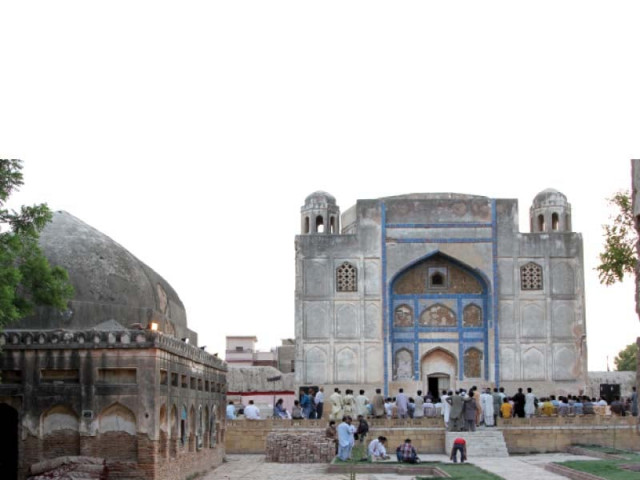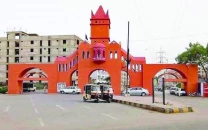Fading from memory: Kalhoro's tiled marvel beckons those who wish to renew its glory
Endowment Fund Trust takes a group of Karachi residents to discover Hyd's heritage

Most of the blue tiles that adorned the mausoleum of Mian Ghulam Shah Kalhoro, the former ruler of Hyderabad, have disappeared over time. PHOTOS: AYSHA SALEEM/EXPRESS
Underneath is a crowd of people discussing the restoration of Mian Ghulam Shah Kalhoro's mausoleum, the former ruler of Hyderabad, who lay peacefully inside the fading monument of his past glory. The group travelled from Karachi to visit the monument and discuss ways for its rehabilitation.
"We had more than 13,000 historical sites to catalogue and then prioritise since this Endowment Trust Fund was set," said Jahangir Siddiqui, the chairperson of the board of trustees for Endowment Fund Trust that is working for the preservation of Sindh's heritage. We have spent nearly Rs1.2 billion on its restoration, he told the audience, gathered to discuss the restoration of this oldest building in Hyderabad.
Read: Culture and heritage: Rediscovering a conspicuously indistinct Hyderabad
Marvi Mazhar, architect and heritage consultant, suggested involving local colleges and university students. They should be a part of the research through internships on these heritage sites so that they can get involved, she said.
Her point was proven when a member of the crowd admitted that she had lived in Hyderabad for the past 10 years and had never known about Kalhoro's tomb.
If the trust has decided to start restoring the tombs, now is as good a time as ever. Encroachments have already cropped up all around the structure. The cement used on the walls to restore the brick structure in the past has further deteriorated it.

Most of the blue tiles that adorned the mausoleum of Mian Ghulam Shah Kalhoro, the former ruler of Hyderabad, have disappeared over time. PHOTOS: AYSHA SALEEM/EXPRESS
The blue tiles on the facade are soothing to the eyes and the graves around the mausoleum are still frequented by many people. Inside the mausoleum, the faded fresco still shows maroon and green flowers painted on the walls and remnants of the fresco, which still has real gold painted on the flowers. There are several copies of the Holy Quran lying on two small cradles near the grave, the smell of extinguished diyas wafting through as a reminder of the routine the faithful follow at the graves.
Read: Celebrating heritage: ‘Greater Iqbal Park to take youth back to their roots’
The structure offers an inspiring view of Hyderabad city if you use the small door at the back of the structure to climb to the roof.
For the love of marbles
The man lying within the mausoleum is often known as the Shah Jahan of Sindh due to his love for magnificent buildings and marbles. Kalhoro (1757-1772AD) was one of the most powerful rulers of the Kalhora Dynasty, known for his strategic military victories that expanded the realm of Sindh.
He was titled 'Shah Wardi Khan' by the Afghan King of the time and was responsible for the two architectural marvels of his time, namely the mausoleum of Shah Abdul Latif Bhitai and the establishment of the city of Hyderabad. He died of a sudden attack of paralysis when he ordered the foundation of a mud fort to be built on a mound in Hyderabad.
During the construction of the mud fort, several graves of followers of saint, Haji Muhammad Makai, were destroyed. Locals believe that it was the saint’s wrath that led to Kalhoro’s untimely demise.
.
Published in The Express Tribune, July 5th, 2015.



















COMMENTS
Comments are moderated and generally will be posted if they are on-topic and not abusive.
For more information, please see our Comments FAQ